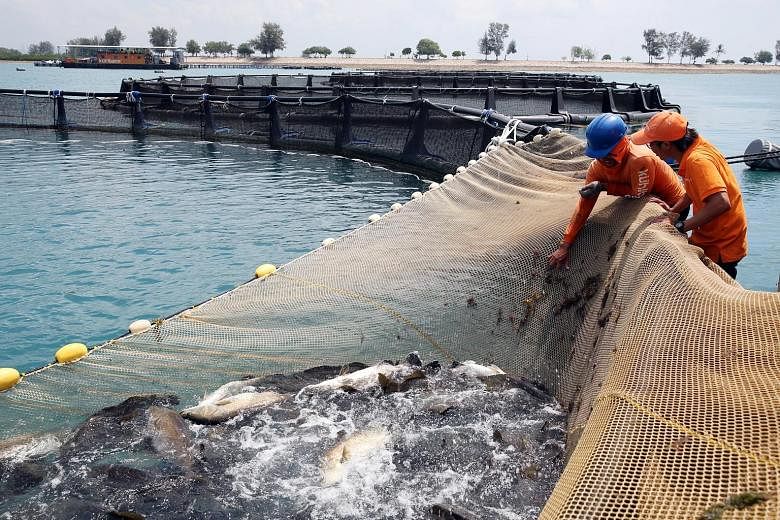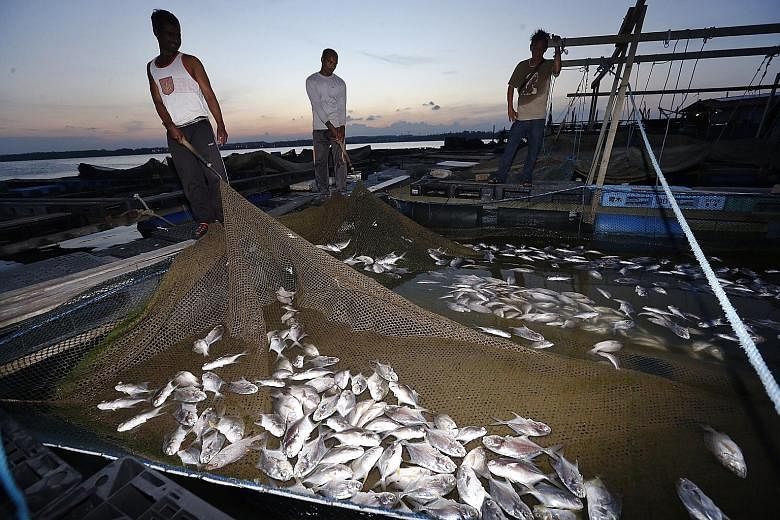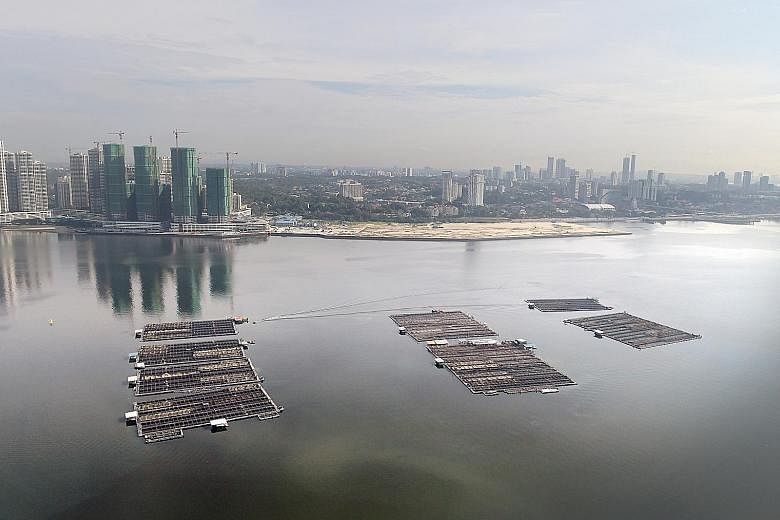The fish-rearing capacity of the narrow body of water to Singapore's north, where almost all the nation's offshore fish farms are located, could soon reach maximum production levels as the country scales up local food production.
So to further boost the Republic's resilience against disruptions to global supply chains, as what is happening amid the ongoing Covid-19 outbreak, the authorities have now set their sights on the nation's southern waters for aquaculture.
A spokesman for the Singapore Food Agency (SFA) said the agency has conducted a broad scan of the southern waters for potential aquaculture sites for sustainable farming systems. "Various spatial, production and environmental constraints were taken into consideration to determine potential sites," she added.
There is now only one deep-sea fish farm in the southern Singapore Strait, Barramundi Asia, which occupies two sites. Over in the Johor Strait are 108 coastal fish farms that make up the bulk of Singapore's 110 licensed sea-based fish farm sites.
Last year, local farms produced about 4,700 tonnes of fish - or about 10 per cent of total consumption.
The Straits Times has learnt that a study commissioned by SFA has shown that certain sites north of the mainland are nearing carrying capacity, which indicates maximum production levels.
Production above the maximum levels could result in poorer water quality within the farming zones and impact farm productivity, the SFA spokesman said.
But the study also found that overall, implementing management measures would support higher production levels of the aquaculture zones, an SFA spokesman said.
She did not elaborate on what these measures could be, but said the agency would be engaging stakeholders like nature groups and farmers as part of its planning and assessment for the development of the aquaculture zones in the Johor Strait.
SCIENCE-BASED STRATEGIES
Professor Dean Jerry, an aquaculture expert, said expanding aquaculture zones could dramatically increase home-grown aquaculture products, especially as companies move towards a high-volume, industrial-scale production model.
"Marine aquaculture if done on an industrial scale is one of the most efficient animal protein producing sectors available," said Prof Jerry, director of the Tropical Futures Institute at James Cook University Singapore.
"Opening up new areas for aquaculture and encouraging innovative and industrial-scale operators to take up sites could double current production volumes very quickly once farms are established."
But industrial aquaculture also comes with its challenges, he said, pointing to factors such as the need for good disease control and tailoring fish feed to the species being reared in order to achieve maximum productivity.
The marine environment the fish are reared in is also important, he said. Unlike land-based fish farms, where fish are reared in enclosed tanks, many offshore fish farms keep their fish in netted pens in the sea, which means the fish are exposed to the surrounding environmental conditions.
Prof Jerry said that in Singapore, the carrying capacity of a body of water for aquaculture depends on how the marine environment copes with additional pressure.
Considerations include whether there is enough dissolved oxygen in the water to accommodate more fish, or if the ecosystem can process fish waste or uneaten food in a way that does not cause any imbalance to the water's nutrient level.
An imbalance in the amount of nutrients such as nitrogen, which is present in fish waste, could cause harmful algae blooms. These blooms have in the past resulted in mass fish deaths in Singapore.
OTHER CONSIDERATIONS
But beyond the ecological considerations, observers and industry players say other factors could also determine Singapore's aquaculture output levels.
Demand for local produce is one factor.
A spokesman for Barramundi Asia said the company produces about 700 tonnes of fish annually, with about 60 tonnes harvested on a monthly basis. But due to the decline in sales to restaurants and hotels in the ongoing Covid-19 outbreak, the company has been harvesting lower volumes of fish over the past two months, he said.
"During this crisis, we hope consumers will choose to support local produce and purchase our Kuhlbarra barramundi from our online store," he added.
Over the longer term, Barramundi Asia has a plan to farm over 5,000 tonnes of fish in Singapore between 2026 and 2030 in support of the Singapore Government's target of meeting 30 per cent of nutritional needs with locally grown or reared produce by 2030.
But the spokesman added: "Our biggest challenges to ramping up production includes not having access to additional marine sea leases to scale up production and lack of growth financing to support our expansion plans in a sustainable way."
So the news that there were plans to increase aquaculture zones in the south was welcome news indeed, he said.
Another consideration in space-constrained Singapore is the competing uses for marine space, noted Prof Jerry.
"Other challenges to expanding aquaculture in the southern waters could relate to safe shipping, recreational use, and building up the infrastructure for energy supply for farming operations," he said.
Singapore's southern waters are more open than the Johor Strait, which is sheltered from currents due to the Causeway and land masses sandwiching the narrow body of water.
As a result, the Republic's southern waters are home to unique habitats not found in the north, such as coral reefs, which support marine life ranging from dolphins to reef sharks. The Sisters' Islands Marine Park is also located off the southern coast.
Mr Stephen Beng, chair of the Friends of Marine Park community, said the ongoing Covid-19 outbreak has shown that planning for Singapore's food security over the long term is crucial for the nation's survival.
But the impact of aquaculture on the natural marine environment must be a key consideration, he said.
"It's not as easy to control the negative impacts of sea farms than it is with land ones. We can't put fences or drains in the sea to stop pollution and disease," said Mr Beng, who is also chair of the marine conservation group of Nature Society (Singapore).
"Efforts must focus first on northern farms to be as productive as they can be, with control measures in place before considerations for more in the south," he added, pointing to the need for rigorous environmental impact assessments ahead of any operations that could potentially cause pollution.
SFA said it will be engaging the nature groups to ensure that measures are put in place so aquaculture activities do not adversely impact the marine environment.
Its spokesman added: "We will also conduct a detailed study of the potential environmental impact for each potential site."




